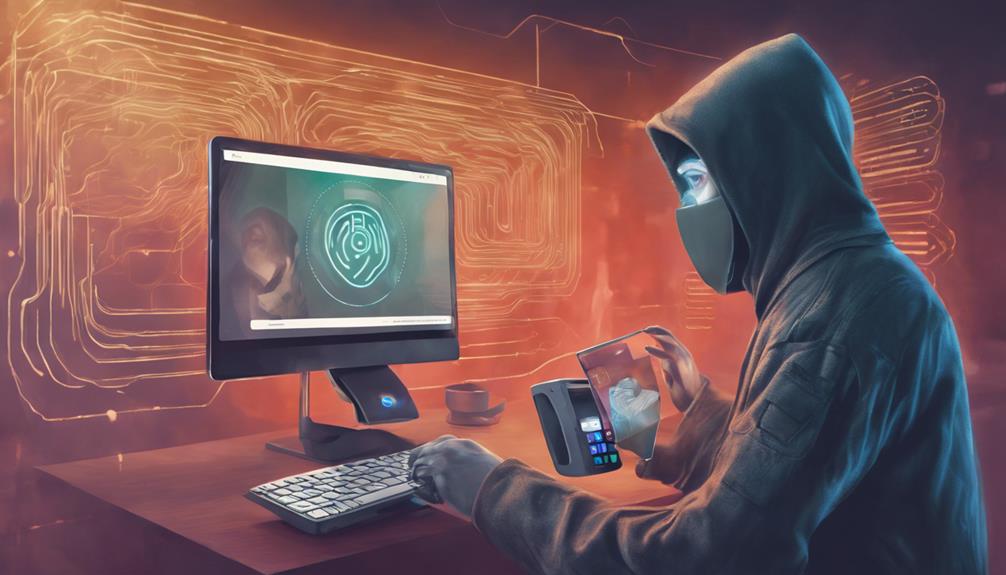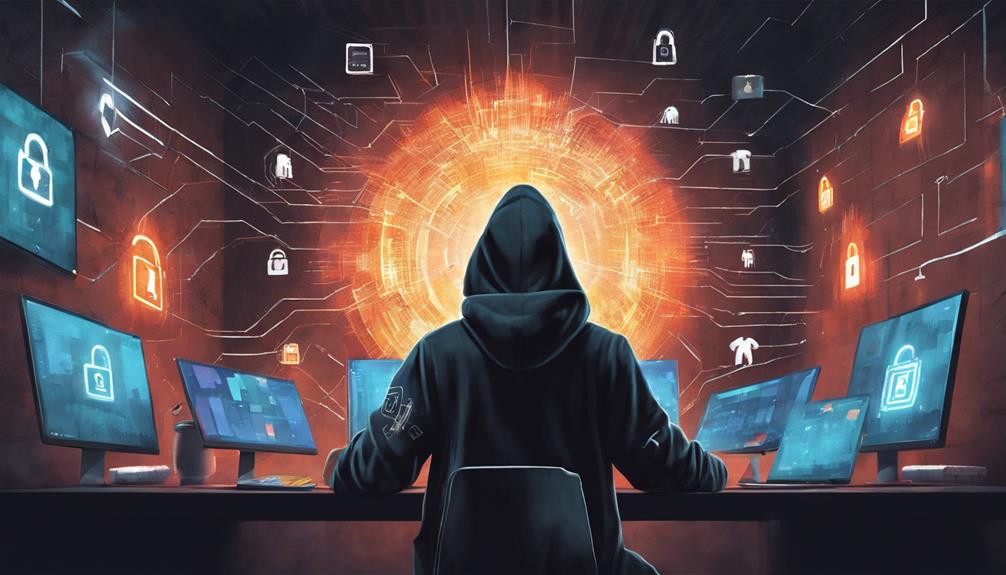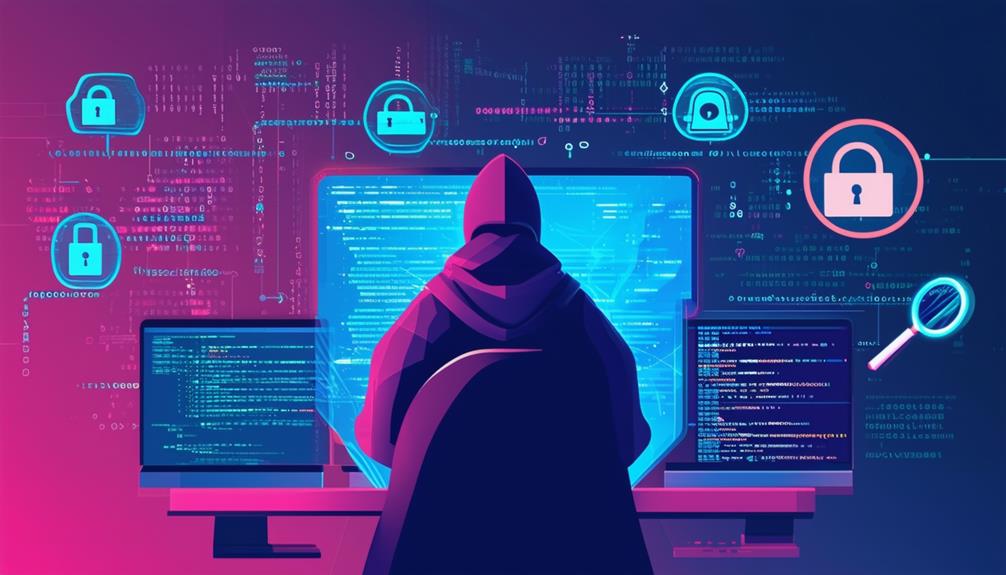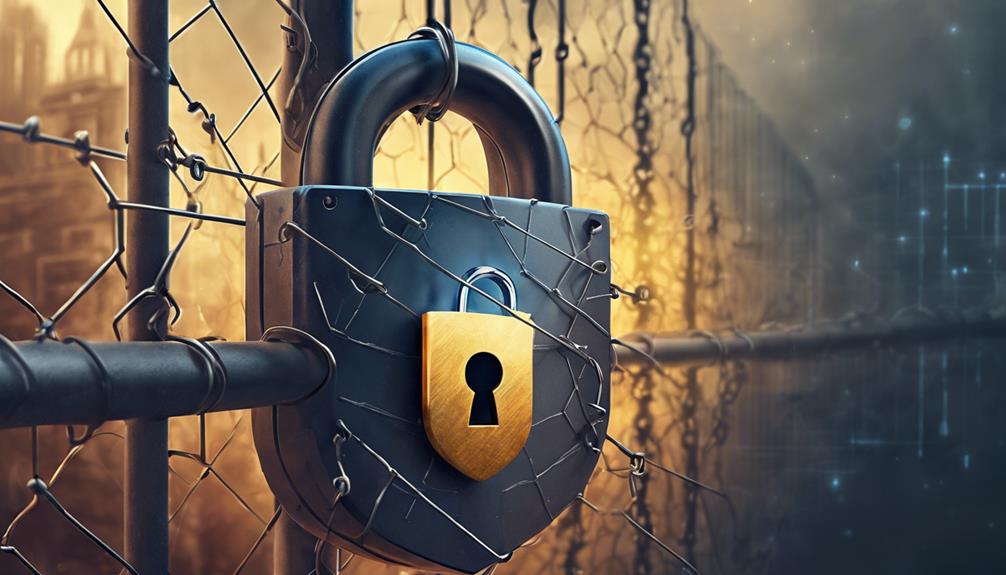Google Pay implements robust security measures like encryption, virtual card numbers, and two-factor authentication to shield users from hacking threats, ensuring secure transactions and safeguarding data integrity. Biometric authentication adds an extra layer of protection against unauthorized access. Advanced encryption and tokenization technologies strengthen security measures against data breaches. Google's secure storage practices enhance user information protection. Remote device security features such as 'Find My Phone' further mitigate risks. For detailed insights on how Google Pay ensures safety from hackers, explore further into its security features and importance of secure transactions.
Key Takeaways
- Google Pay employs robust security measures like encryption and virtual card numbers.
- Two-factor authentication adds an extra layer of protection against potential threats.
- Regular monitoring and strong password protection are essential for safeguarding against hackers.
- Biometric authentication enhances security by providing unique identification.
- Utilizing encryption, tokenization, and secure storage practices fortify Google Pay against data breaches.
Google Pay Security Measures
Google Pay employs robust security measures to safeguard users' financial information during transactions. One key component of Google Pay's security architecture is the use of virtual card numbers. These virtual card numbers act as a shield for users' actual card numbers, adding an extra layer of protection against potential threats.
When a transaction is initiated, the information is encrypted not only from the user's device but also on the recipient's end, ensuring that sensitive data remains secure throughout the process.
Furthermore, Google takes additional steps to safeguard user data by encrypting information stored on its servers. By implementing recommended security measures such as two-factor authentication, Google Pay enhances the safety of transactions, providing users with added peace of mind.
While no system is impervious to all risks, Google Pay's security features make it a relatively secure payment option for users seeking to protect their financial information during online transactions.
Potential Vulnerabilities to Watch For

To enhance the security of financial transactions conducted through digital platforms, users must remain vigilant for potential vulnerabilities that could compromise their sensitive information. Hackers often target weak passwords or employ phishing attacks to gain unauthorized access to Google Pay accounts, potentially exposing users' personal data.
It is vital for individuals to exercise caution when sharing any personal information online and to refrain from clicking on suspicious links that could lead to hacking attempts.
Although Google Pay implements robust security measures such as encryption and virtual card numbers to protect user data, vigilance on the part of the user is essential. Regularly monitoring account activity and enabling two-factor authentication can further fortify defenses against potential breaches.
In the unfortunate event of unauthorized transactions, swift reporting and resolution are necessary to mitigate risks associated with the compromise of personal data.
Tips to Enhance Google Pay Security

To improve the security of your Google Pay account, it is essential to prioritize strong password protection. Strong passwords act as a barrier against unauthorized access. Enabling two-factor authentication provides an added layer of verification. By staying vigilant and reviewing your transactions regularly, you can quickly identify any unusual activity. Taking necessary actions to safeguard your financial information is crucial.
Strong Password Protection
Implementing strong password protection measures is vital for enhancing the security of your Google Pay account. When creating a password, avoid using easily guessable information such as birthdays or names. Opt for a combination of letters, numbers, and special characters to make it harder for hackers to crack.
Regularly updating your password and refraining from sharing it with others are essential steps to maintain the security of your Google Pay account. By incorporating biometric recognition features like fingerprint or face ID, you can add an extra layer of security to your transactions.
These additional security measures help safeguard your personal and financial information from unauthorized access. Remember, a strong password is your first line of defense against potential security breaches, so take the time to create a secure and unique password for your Google Pay account.
Enable Two-Factor Authentication
Enhancing the security of your Google Pay account can be achieved by enabling two-factor authentication, an important step in safeguarding your financial information from potential hackers. Two-factor authentication adds an extra layer of security by requiring a second verification step, such as a code sent to your phone, to access your account.
This additional step helps prevent unauthorized access even if your password is compromised. By enabling two-factor authentication, you greatly enhance the security of your Google Pay transactions, making it a recommended security measure to protect your financial information from potential threats.
This feature guarantees that only authorized users can access your account, reducing the risk of unauthorized transactions and potential breaches. By incorporating two-factor authentication into your Google Pay account, you add a vital barrier that strengthens the overall security posture of your financial transactions, providing you with peace of mind and confidence in the safety of your sensitive information.
Regularly Monitor Transactions
Monitoring transactions regularly is an essential practice to enhance the security of your Google Pay account and protect your financial information from potential threats. By setting up transaction notifications, you can stay informed about all activities occurring within your Google Pay account.
It is vital to review your transaction history frequently to detect any unauthorized or suspicious transactions promptly. Should you identify any transactions that you did not authorize, it is imperative to report them immediately to Google Pay for thorough investigation and resolution.
Additionally, maintaining a secure Google account by using strong passwords and enabling two-factor authentication adds an extra layer of protection against unauthorized access. Moreover, remaining vigilant for phishing scams or fraudulent emails posing as Google Pay can safeguard your account from potential hackers.
Biometric Authentication and Its Role

Biometric authentication plays a pivotal role in bolstering the security measures of Google Pay transactions by providing a unique and robust layer of identity verification. By incorporating biometric data, such as fingerprints or facial recognition, Google Pay enhances security by making it challenging for hackers to replicate or access users' accounts. This method guarantees that only authorized individuals can initiate transactions, greatly reducing the risks associated with unauthorized access or identity theft. Google Pay's utilization of biometric authentication not only enhances security but also provides a convenient way for users to verify their identity securely.
| Benefits of Biometric Authentication | Explanation |
|---|---|
| Unique Identification | Difficult to replicate |
| Enhanced Security | Reduces unauthorized access |
| Convenient Verification | Secure identity verification |
Safeguarding Against Data Breaches

Google Pay employs various security measures to prevent data breaches, such as using virtual card numbers for transactions, encrypting information during transactions, and securing stored data with encryption.
By following Google's recommended security practices, users can enhance their protection against potential hacking attempts.
Google Pay's commitment to user privacy is evident through continuous updates to its security features, reflecting its dedication to mitigating risks associated with data breaches.
Data Breach Prevention
Utilizing advanced encryption techniques and tokenization technology plays a significant role in fortifying the security measures of digital payment platforms like Google Pay against potential data breaches. Encryption ensures that sensitive data remains secure during transactions, making it challenging for hackers to intercept and steal information. Tokenization adds an extra layer of protection by generating virtual card numbers, safeguarding actual card details from exposure in the event of a data breach. Google's storage of encrypted user information on servers further enhances security, making it difficult for unauthorized access to personal data. Additionally, implementing security measures such as two-factor authentication and regular password updates can strengthen protection against data breaches. In the context of a breach, Google Pay's fraud protection policies are designed to mitigate financial losses and safeguard user accounts.
| Data Breach Prevention Measures | Benefits |
|---|---|
| Encryption Techniques | Enhanced Security |
| Tokenization Technology | Protection of Card Details |
| Secure Storage Practices | Difficulty in Unauthorized Access |
| Recommended Security Measures | Strengthened Data Protection |
Security Measures Overview
To bolster protection against data breaches, robust security measures are essential for safeguarding digital payment platforms like Google Pay. When it comes to securing digital payments, Google Pay adopts several key security measures:
- Virtual Card Numbers: Google Pay employs virtual card numbers for transactions, adding an extra layer of security that helps protect users' sensitive financial information from potential hackers.
- End-to-End Encryption: Transactions conducted through Google Pay are encrypted on both ends, ensuring that data remains protected during transmission and making it harder for cybercriminals to intercept and misuse valuable information.
- Server-side Encryption: Information stored on Google's servers is encrypted, enhancing the overall security posture of the platform and safeguarding against potential data breaches that could compromise users' data integrity.
Importance of Secure Transactions

Ensuring the security of transactions is paramount in safeguarding sensitive information and preventing unauthorized access during online payments, especially when using credit cards.
In the case of Google Pay, robust encryption technologies are employed to securely transmit transaction data, reducing the risk of interception by malicious actors.
Additionally, Google Pay enhances security by generating virtual card numbers, which act as substitutes for actual credit card details, adding an extra layer of protection against fraud and unauthorized use.
Remote Device Security Measures

In the context of maintaining the security of online transactions, implementing remote device security measures becomes essential to enhance the protection of sensitive payment information. Utilizing features like Find My Phone can greatly strengthen the safety of mobile wallets by allowing users to locate, lock, or erase data on a lost or stolen device remotely.
Here are three key reasons why incorporating remote device security measures is important:
- Preventing Unauthorized Access: By enabling Find My Phone or similar functionalities, individuals can remotely disable their devices, thereby preventing unauthorized access to their payment information in case of loss or theft.
- Adding an Extra Layer of Protection: These security measures provide an additional layer of protection to mobile payment solutions, reducing the likelihood of sensitive data falling into the wrong hands.
- Mitigating Risks: Utilizing remote security options such as Find My Phone helps mitigate risks associated with potential unauthorized transactions, enhancing overall security measures for online payments.
Frequently Asked Questions
How Safe Is Google Pay From Hackers?
Google Pay employs advanced security measures like virtual card numbers, end-to-end encryption, and encrypted storage. While no system is invulnerable to hackers, Google Pay's robust security features enhance protection against unauthorized access, prioritizing user data privacy.
How Secure Is Google Pay?
Google Pay offers a robust security infrastructure by utilizing virtual card numbers, encryption for transactions, and data storage encryption. Additional safeguards like screen locks and biometric authentication further enhance security. While no system is foolproof, Google Pay provides a relatively secure digital payment option.
Can Someone Use Google Pay if They Steal Your Phone?
In the scenario of phone theft, if someone gains possession of your device, they could potentially use Google Pay if they are able to bypass the device security measures and obtain access to your Google account credentials.
What Are the Disadvantages of Google Pay?
In exploring the domain of digital payments, one must heed the shadows lurking in the alleys of convenience. The disadvantages of Google Pay lie in vulnerabilities to phishing, scams, and unauthorized access, necessitating vigilant guardianship over one's account.
Conclusion
To sum up, safeguarding your financial information on Google Pay is like building a fortress around your treasures in a digital world full of hidden dangers.
By implementing strong security measures, staying vigilant against potential vulnerabilities, and utilizing biometric authentication, you can fortify your defenses against cyber threats.
Remember, protecting your data is not a luxury, but a necessity in today's interconnected landscape.









